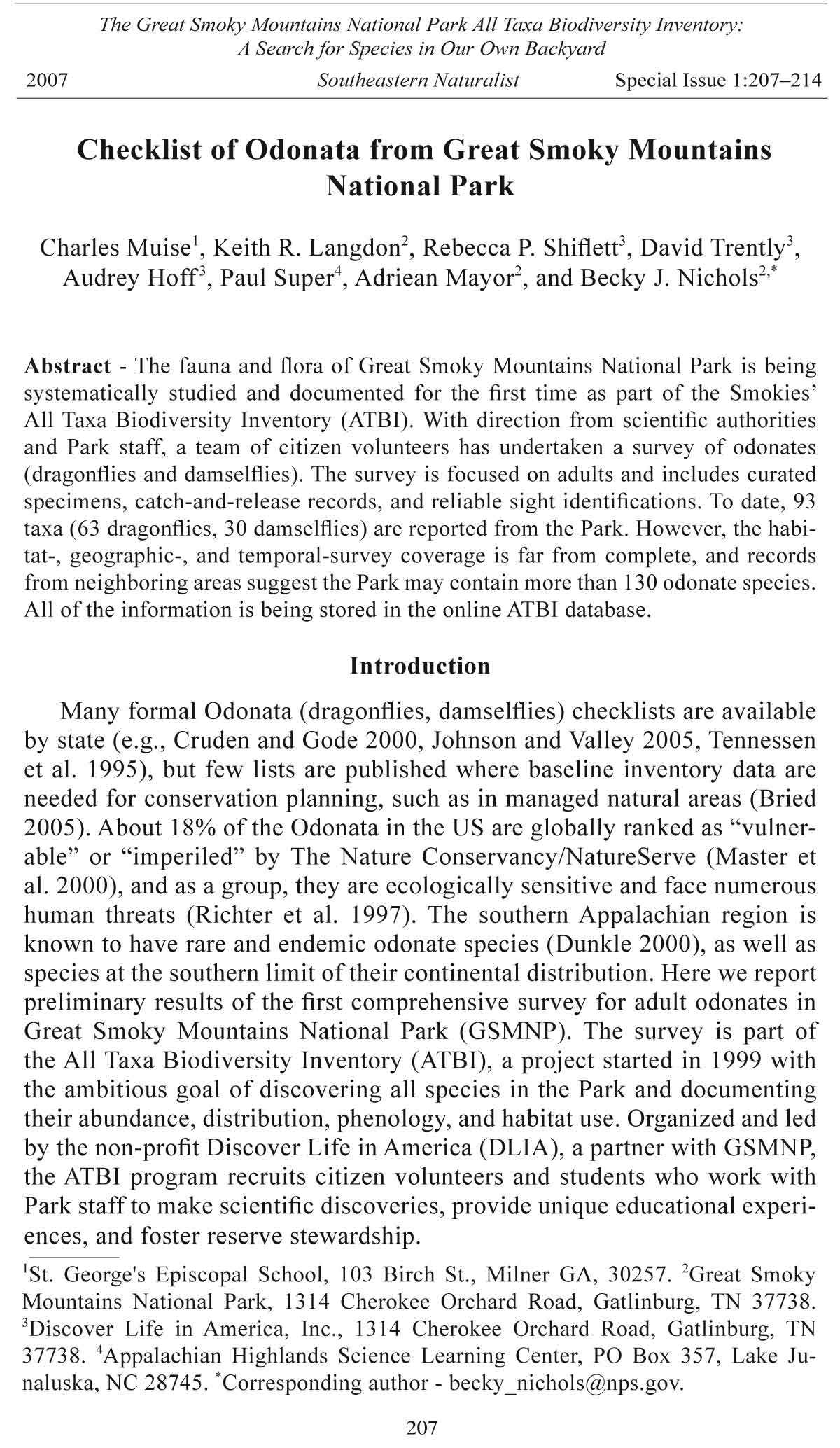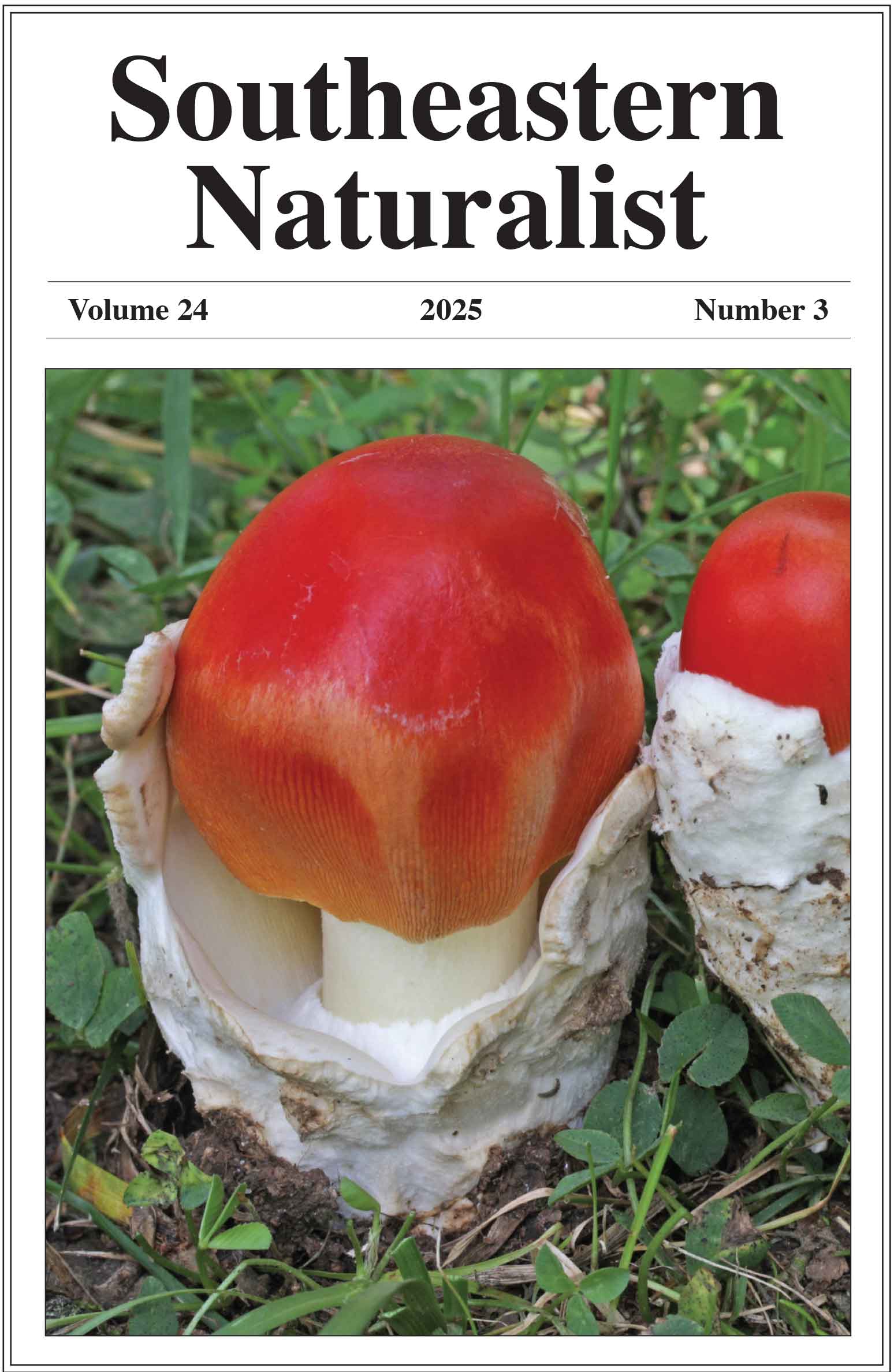1St. George's Episcopal School, 103 Birch St., Milner GA, 30257. 2Great Smoky
Mountains National Park, 1314 Cherokee Orchard Road, Gatlinburg, TN 37738.
3Discover Life in America, Inc., 1314 Cherokee Orchard Road, Gatlinburg, TN
37738. 4Appalachian Highlands Science Learning Center, PO Box 357, Lake Junaluska,
NC 28745. *Corresponding author - becky_nichols@nps.gov.
Checklist of Odonata from Great Smoky Mountains
National Park
Charles Muise1, Keith R. Langdon2, Rebecca P. Shifl ett3, David Trently3,
Audrey Hoff
3, Paul Super4, Adriean Mayor2, and Becky J. Nichols2,*
Abstract - The fauna and fl ora of Great Smoky Mountains National Park is being
systematically studied and documented for the first time as part of the Smokies’
All Taxa Biodiversity Inventory (ATBI). With direction from scientific authorities
and Park staff, a team of citizen volunteers has undertaken a survey of odonates
(dragonfl ies and damselfl ies). The survey is focused on adults and includes curated
specimens, catch-and-release records, and reliable sight identifications. To date, 93
taxa (63 dragonfl ies, 30 damselfl ies) are reported from the Park. However, the habitat-,
geographic-, and temporal-survey coverage is far from complete, and records
from neighboring areas suggest the Park may contain more than 130 odonate species.
All of the information is being stored in the online ATBI database.
Introduction
Many formal Odonata (dragonfl ies, damselfl ies) checklists are available
by state (e.g., Cruden and Gode 2000, Johnson and Valley 2005, Tennessen
et al. 1995), but few lists are published where baseline inventory data are
needed for conservation planning, such as in managed natural areas (Bried
2005). About 18% of the Odonata in the US are globally ranked as “vulnerable”
or “imperiled” by The Nature Conservancy/NatureServe (Master et
al. 2000), and as a group, they are ecologically sensitive and face numerous
human threats (Richter et al. 1997). The southern Appalachian region is
known to have rare and endemic odonate species (Dunkle 2000), as well as
species at the southern limit of their continental distribution. Here we report
preliminary results of the first comprehensive survey for adult odonates in
Great Smoky Mountains National Park (GSMNP). The survey is part of
the All Taxa Biodiversity Inventory (ATBI), a project started in 1999 with
the ambitious goal of discovering all species in the Park and documenting
their abundance, distribution, phenology, and habitat use. Organized and led
by the non-profit Discover Life in America (DLIA), a partner with GSMNP,
the ATBI program recruits citizen volunteers and students who work with
Park staff to make scientific discoveries, provide unique educational experiences,
and foster reserve stewardship.
207
The Great Smoky Mountains National Park All Taxa Biodiversity Inventory:
A Search for Species in Our Own Backyard
2007 Southeastern Naturalist Special Issue 1:207–214
208 Southeastern Naturalist Special Issue 1
As the largest fully protected reserve in the upland southeast region,
GSMNP is committed to surveying for all its biotic resources; yet until recently,
there have been few comprehensive surveys of invertebrate groups.
Several odonate species were added to the Park list during early surveys (Cook
1947) and brief collecting trips led by The Dragonfl y Society of the Americas.
Most odonate records have come from independent efforts by odonate specialists
over the past several decades, and from the Park’s long-term aquatic
macroinvertebrate monitoring program (started in 1992). However, records
from literature accounts and museum holdings were not compiled until as
recently as 2004, when the Park odonate list included only 35 species. This
incomplete list and the mission of the ATBI prompted a group of interested parties
to conduct the first comprehensive inventory of Odonata in GSMNP. The
group was dubbed “Team Odonate” and included DLIA volunteers, Park staff
in the Resource Management and Science Division, Great Smoky Mountains
Institute at Tremont (GSMIT) staff, and student interns from the Appalachian
Highlands Science Learning Center at Purchase Knob. This paper provides
a preliminary checklist of Odonata in GSMNP, with emphasis on activities
of Team Odonate. The objectives of Team Odonate are to maximize the Park
species list, expand knowledge of species’ distributions and phenology, and
provide educational experiences.
Study area
Great Smoky Mountains National Park contains ≈2200 km2 straddling
eastern Tennessee and western North Carolina. The Park receives uniformly
distributed precipitation regulated by maritime tropical air masses that move
northeastward from the Gulf of Mexico. The precipitation regime (120–250
cm per year) and topographic variation (elevation range = 300–2000 m above
sea level) promote a wide array of aquatic and wetland habitats. The Park
contains over 3500 km of permanent streams and rivers. There also are numerous
small wetlands in the mountain valleys, countless seeps, and scattered
ephemeral ponds perched atop karst geology; natural wetlands in the southern
Appalachians can support a high diversity of rare species in the southeastern
US (Weakley and Schafale 1995). Artificially occurring wetlands such as
small farm impoundments occupy portions of the larger valleys in the Park.
Two large reservoirs were established in the mid-twentieth century along the
southwest edge.The reservoirs have embayed former low-elevation valleys,
destroying long sections of natural streams and rivers and presumably wetlands.
Tributaries empty into the embayed sections of these reservoirs, creating
unique habitat opportunities for odonates and other aquatic biota. Much of the
present-day reserve was logged prior to National Park designation in 1934. See
Jenkins (2007) for a description of the Park's vegetation communities.
Methods
Wetlands, ponds, and upland meadows, and to a lesser extent, streams,
rivers, and reservoirs, were sampled throughout the Park starting in late
2007 C. Muise et al. 209
2004. Study sites were visited repeatedly to account for species’ seasonality
and maximize chances for detection. Repeat visits over the flight season
helped establish tentative flight periods in the Park, although we felt this
information was too premature to report here. Fifteen sites were sampled
at least once by five to eight observers at a time. Sites in Cades Cove and
Tremont (both in the northwest quadrant of the Park) were sampled more
frequently with the assistance of student volunteers (see below). Four sites
in Cades Cove were visited at least 15 times during the period of November
2004 through October 2005. Overall, an estimated 75% of the survey
effort was concentrated in the Tennessee portion of the Park, especially in
the west end.
More than 100 middle school and high school students participated in
the field survey. They worked mostly at wetlands and ponds in the Cades
Cove and Tremont area. Altogether, these youth groups joined ≈40 field excursions
over a two-year period. High school interns stationed at Purchase
Knob sampled the lesser-known North Carolina side of the Park, especially
sections of the Oconaluftee River.
Most species were identified by sight or following capture, often with the
aid of close-focusing binoculars and recently published field guides (e.g.,
Abbott 2005, Dunkle 2000, Lam 2004). Odonates that were difficult to identify,
or possibly new to the Park, were euthanized or chilled, later identified,
and released. Specimens were preserved in acetone (≈12-hr submersion),
placed in clear envelopes, and labeled. Identifications of prepared specimens
were made using standard keys (Needham et al. 2000, Westfall and May
1996). Vouchers of most species collected by Team Odonate are currently
housed at GSMIT and Park offices prior to accession into the Park museum.
All records were entered into the Interim ATBI Database developed by the
United States Geological Survey and GSMNP. This system allows easy
retrieval of geographic, statistical, phenological, and reference data about
each entry, species, or higher taxonomic group. The database also was used
to store ancillary information such as weather notes taken each survey, site
habitat features, and site UTM coordinates.
Results
Reliable records now exist for 93 species of Odonata (63 dragonfl ies,
30 damselfl ies) in GSMNP (Table 1). ATBI Team Odonate added 17 species
(7 dragonfl ies, 10 damselfl ies) to the Park list during two field seasons
(2004, 2005). Additional data were consolidated from the GSMNP museum
collection, which contained odonate specimens from as early as 1935, and
from contributions by Carl Cook, Ken Tennessen, Jerrell Daigle, Bryan
Reece, Dan Johnson, and Steve Fraley (larval samples). The combination of
systematic field surveys and compiling historical records has nearly tripled
the Park's odonate species list since 2004. Noteworthy species on the list
include: Lanthus parvulus (Northern pygmy clubtail), a new record and
a species at the southern limit of its range in the Park, and Somatochlora
210 Southeastern Naturalist Special Issue 1
Table 1. Preliminary checklist of Odonata from Great Smoky Mountains National Park (current
as of April 2007). New records obtained by Team Odonate are indicated with an asterisk (*).
Scientific name Common name
Anisoptera (dragonfl ies)
Petaluridae
Tachopteryx thoreyi Hagen Gray petaltail
Aeshnidae
Aeshna constricta Say* Lance-tipped darner
A. umbrosa Walker Shadow darner
Anax junius Drury Common green darner
Anax longipes Hagen Comet darner
Basiaeschna janata Say Springtime darner
Boyeria grafiana Williamson Ocellated darner
B. vinosa Say Fawn darner
Epiaeschna heros F. Swamp darner
Gomphidae
Arigomphus villosipes Selys Unicorn clubtail
Dromogomphus spinosus Selys Black-shouldered spinyleg
Gomphus adelphus Selys Mustached clubtail
G. exilis Selys Lancet clubtail
G. lividus Selys Ashy clubtail
G. parvidens Currie Piedmont clubtail
G. rogersi Gloyd Sable clubtail
Hagenius brevistylus Selys Dragonhunter
Lanthus parvulus Selys* Northern pygmy clubtail
Lanthus vernalis Carle Southern pygmy clubtail
Ophiogomphus incurvatus alleghaniensis Carle Appalachian snaketail
O. mainensis Packard Maine snaketail
O. rupinsulensis Walsh Rusty snaketail
Stylogomphus albistylus Hagen Eastern least clubtail
Stylurus scudderi Selys Zebra clubtail
Cordulegastridae
Cordulegaster bilineata Carle Brown spiketail
C. erronea Hagen Tiger spiketail
C. maculata Selys Twin-spotted spiketail
C. obliqua Say Arrowhead spiketail
Macromiidae
Didymops transversa Say Stream cruiser
Macromia alleghaniensis Williamson Allegheny river cruiser
M. illinoiensis Walsh Swift river cruiser
Corduliidae
Epitheca cynosura Say Common baskettail
E. princeps Hagen* Prince baskettail
Helocordulia uhleri Selys* Uhler’s sundragon
Neurocordulia virginiensis Davis Cinnamon shadowdragon
N. yamaskanensis Provancher Stygian shadowdragon
Somatochlora elongata Scudder* Ski-tailed emerald
S. linearis Hagen Mocha emerald
S. provocans Calvert Tree-top emerald
S. tenebrosa Say Clamp-tipped emerald
S. williamsoni Walker Williamson’s emerald
Libellulidae
Celithemis fasciata Kirby Banded pennant
Erythemis simplicicollis simplicicollis Say Eastern pondhawk
Ladona deplanata Rambur Blue corporal
2007 C. Muise et al. 211
Table 1, continued.
Scientific name Common name
Libellula axilena Westwood Bar-winged skimmer
L. cyanea F. Spangled skimmer
L. fl avida Rambur* Yellow-sided skimmer
L. incesta Hagen Slaty skimmer
L. luctuosa Burmeister Widow skimmer
L. pulchella Drury Twelve-spotted skimmer
L. semifasciata Burmeister Painted skimmer
L. vibrans F. Great blue skimmer
Pachydiplax longipennis Burmeister Blue dasher
Pantala fl avescens F. Wandering glider
P. hymenaea Say Spot-winged glider
Perithemis tenera Say Eastern amberwing
Plathemis lydia Drury Common whitetail
Sympetrum ambiguum Rambur Blue-faced meadowhawk
S. rubicundulum Say Ruby meadowhawk
S. semicinctum Say* Band-winged meadowhawk
S. vicinum Hagen Autumn meadowhawk
Tramea carolina L. Carolina saddlebags
T. lacerata Hagen Black saddlebags
Zygoptera (damselfl ies)
Calopterygidae
Calopteryx amata Hagen Superb jewelwing
C. angustipennis Selys Appalachian jewelwing
C. maculata Beauvois Ebony jewelwing
Hetaerina americana F. American rubyspot
Lestidae
Lestes australis Walker Southern spreadwing
L. congener Hagen* Spotted spreadwing
L. eurinus Say Amber-winged spreadwing
L.forcipatus Rambur Sweetfl ag spreadwing
L. rectangularis Say Slender spreadwing
L. vigilax Hagen Swamp spreadwing
Coenagrionidae
Amphiagrion saucium Burmeister Eastern red damsel
Argia apicalis Say Blue-fronted dancer
A. fumipennis fumipennis Burmeister* Smoky-winged dancer
A. fumipennis violacea Hagen Violet dancer
A. moesta Hagen Powdered dancer
A. tibialis Rambur* Blue-tipped dancer
A. translata Hagen* Dusky dancer
Chromagrion conditum Hagen Aurora damsel
Enallagma aspersum Hagen Azure bluet
E. basidens Calvert* Double-striped bluet
E. civile Hagen Familiar bluet
E. divagans Selys* Turquoise bluet
E. exsulans Hagen* Stream bluet
E. geminatum Kellicott* Skimming bluet
E. signatum Hagen Orange bluet
E. traviatum Selys* Slender bluet
E. vesperum Calvert* Vesper bluet
Ischnura hastata Say Citrine forktail
I. posita Hagen Fragile forktail
I. verticalis Say Eastern forktail
212 Southeastern Naturalist Special Issue 1
williamsoni (Williamson's emerald) and S. provocans (Tree-top emerald),
last reported from the Park in 1947 (by Carl Cook).
We used county records from the Odonata Central database (Abbott
2006) to compile a list of potential species and estimate the completeness
of the Park list. We included all counties within the Park (Blount, Sevier,
and Cocke in Tennessee; Swain and Haywood in North Carolina), as well
as the counties that border these. Additionally, we included counties along
the Tennessee/North Carolina border north to Virginia that share some of
the Park physiography. Records from 26 counties were gathered, resulting in
41 species of odonates that have not been documented in the Park. Based on
this approach, the expected number of species in the Park may exceed 130,
suggesting the current list (Table 1) is approximately two-thirds complete.
Dot maps of the Park distribution of most species can be displayed by using
the ATBI database, searchable through the DLIA website (www.DLIA.
org). These distributions reveal that, as expected, some species were widespread
while others were found at only one or two sites. The lower-gradient
streams in the west end of the Park provide unique habitat opportunities
and therefore support a relatively rich odonate fauna. The only odonates
observed at elevations above 1000 m were late-season migrants foraging
over open areas and forest canopies. Adult odonates are present in the Park
at least nine months out of the year. Few damselfl y species were reported
after early September during the Team Odonate surveys.
Discussion
More data are required before we can make any reasonable assessment of
each species’ Park-based distribution, phenology, and habitat associations.
Adult odonate distributions can show strong compositional asymmetry even
at local spatial scales (Bried and Ervin 2005), thus it is reasonable to expect
strong compositional variation across the spacious and habitat rich Park
area. Survey efforts in the eastern half of the Park remains sparse, especially
in the remote tributaries connected to Fontana Reservoir. Several wetland
types have not yet been surveyed for odonates, and new wetland types continue
to be discovered in the Park. In general, large streams and rivers and
the North Carolina side of the Park are the most understudied areas with
regard to odonates.
Our preliminary information on species composition, distributions, fl ight
periods, and habitat use has exposed some knowledge gaps and set a benchmark
for long-term monitoring efforts that will help inform conservation
planning in the Park. The current list consolidates new data with previous
efforts by Park staff to correct misidentifications and uncover old museum
and literature records for Park odonates. A new goal for Team Odonate is to
reach the estimated 130+ potential species. The presence this many species
would rival the size of some statewide Odonata lists, such as that of Mississippi
(R.S. Krotzer and J.T. Bried, The Nature Conservancy, Albany NY,
pers. comm.), further testifying to the Park’s high biodiversity value.
2007 C. Muise et al. 213
The project has benefited greatly by combining efforts of Park staff,
partners, youth groups, and local ATBI citizen scientists. The diverse knowledge
and enthusiasm of all volunteers has resulted in a tremendous increase
in odonate information for the Park in a short period of time. While many
of the participants had limited odonate identification skills and experience,
recent publication of user-friendly texts allowed for even novice participants
to identify many species. By inspiring young scientists and encouraging
stewardship within the local community, the benefits of this citizen science
project are multiplying fast.
Acknowledgments
We are grateful for the contributions of Jeanie Hilten, former Director of Discover
Life in America, for organizing and participating in field activities. Carl
Cook provided critical identifications of a difficult taxon, and both Michael Kunze
and Chuck Parker were generous with database assistance. Little would have been
accomplished without the active participation of the many students and citizens involved
in this project. Jason Bried and two anonymous reviewers provided helpful
criticism of earlier drafts of the manuscript.
Literature Cited
Abbott, J.C. 2005. Dragonfl ies and Damselfl ies of Texas and the South-central
United States. Princeton University Press, Princeton, NJ.
Abbott, J.C. 2006. Odonata Central: An Online Resource for Odonates of North
America. Austin, TX. Available online at www.odonatacentral.com. Accessed
March 2006.
Bried, J.T. 2005. Species of adult Odonata from three natural areas in Mississippi.
Journal of the Mississippi Academy of Sciences 50:231–232.
Bried, J.T., and G.N. Ervin. 2005. Distribution of adult Odonata among localized
wetlands in east-central Mississippi. Southeastern Naturalist 4:731-744.
Cook, C. 1947. Notes on the genus Somatochlora collected in Kentucky and Tennessee.
Entomological News 58:127–131.
Cruden, R.W., and O.J. Gode. 2000. The Odonata of Iowa. Bulletin of American
Odonatology 6:13–48.
Dunkle, S.W. 2000. Dragonfl ies through Binoculars: A Field Guide to Dragonfl ies of
North America. Oxford University Press, Oxford, UK.
Jenkins, M.A. 2007. Vegetation Communities of the Great Smokies Mountains.
Southeastern Naturalist 6 (Special Issue 1):35–56.
Johnson, J., and S. Valley. 2005. The Odonata of Oregon. Bulletin of American
Odonatology 8:100–122.
Lam, E. 2004. Damselfl ies of the Northeast: A Guide to the Species of Eastern Canada
and the Northeastern United States. Biodiversity Books, Forest Hills, NY.
Master, L.L., B.A. Stein, L.S. Kutner, and G.A. Hammerson. 2000. Vanishing assets:
Conservation status of US species. Pp. 93–108, In B.A. Stein, L.S. Kutner, and
J.S. Adams (Eds.). Precious Heritage: The Status of Biodiversity in the United
States. Oxford University Press, Oxford, UK.
214 Southeastern Naturalist Special Issue 1
Needham, J.G., M.J. Westfall, Jr., and M.L. May. 2000. Dragonfl ies of North America
(Revised Edition). Scientific Publishers. Gainesville, FL.
Richter, B.D., D.P. Braun, M.A. Mendelson, and L.L. Master. 1997. Threats to imperiled
freshwater fauna. Conservation Biology 11:1081–1093.
Tennessen, K.J., J.D. Harper, and S.K. Krotzer. 1995. The distribution of Odonata in
Alabama. Bulletin of American Odonatology 3:49–74.
Weakley, A.S., and M.P. Schafale. 1995. Non-alluvial wetlands of the Southern Blue
Ridge: Diversity in a threatened ecosystem.Pp. 163–187, In C.C. Trettin, W.M.
Aust, and J. Wisniewski (Eds.). Wetlands of the Interior Southeastern United
States. Kluwer Academic Press, Boston, MA.
Westfall, M.J., Jr., and M.L. May. 1996. Damselfl ies of North America. Scientific
Publishers, Gainesville, FL.














 The Southeastern Naturalist is a peer-reviewed journal that covers all aspects of natural history within the southeastern United States. We welcome research articles, summary review papers, and observational notes.
The Southeastern Naturalist is a peer-reviewed journal that covers all aspects of natural history within the southeastern United States. We welcome research articles, summary review papers, and observational notes.